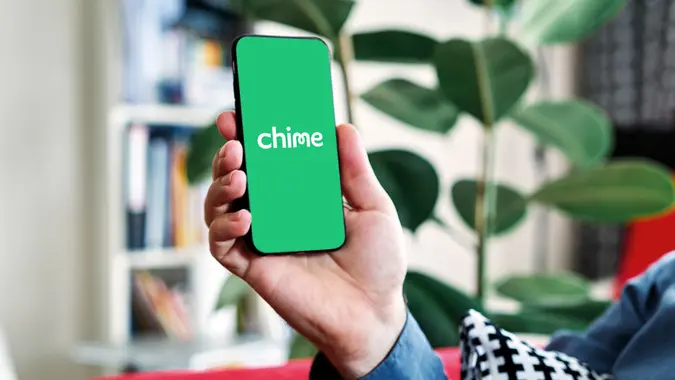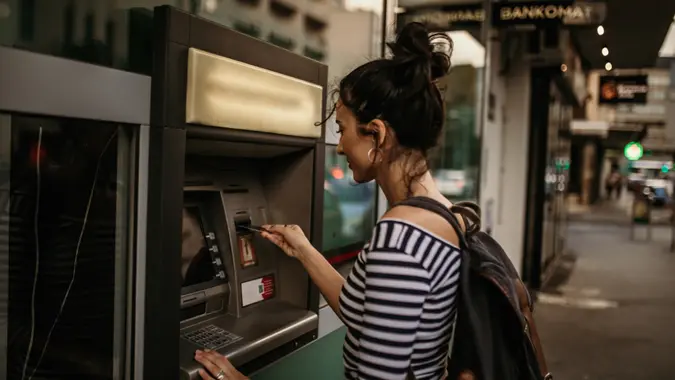How To Wire Money Safely: A Step-by-Step Guide

Commitment to Our Readers
GOBankingRates' editorial team is committed to bringing you unbiased reviews and information. We use data-driven methodologies to evaluate financial products and services - our reviews and ratings are not influenced by advertisers. You can read more about our editorial guidelines and our products and services review methodology.

20 Years
Helping You Live Richer

Reviewed
by Experts

Trusted by
Millions of Readers
When you need to send a large sum of money quickly, a wire transfer can be an ideal solution. Here are the steps to take.
Step 1: Gather Necessary Information
To wire money, you must provide the following information.
- Bank account details for both sender and recipient: Full names, contact information and account numbers
- Routing numbers and SWIFT codes: For domestic transfers, routing numbers are sufficient; for international transfers, the SWIFT/BIC code is also required.
- Reason for transfer: Not all banks will require a reason, but it’s best to be prepared if yours does.
When sending money in person, whether at the bank or via a wire transfer provider, you’ll also need to show a government-issued photo ID.
Step 2: Choose a Wire Transfer Method
You can send wire transfers through your bank, either online or in-person, or through a nonbank money transfer provider.
- Online bank transfers: Most banks will allow you to complete the wire transfer online. Simply log in to your bank account and navigate to the wire transfer page.
- In-person bank bank transfers: You can also meet with a banker to complete your transfer. You may want to call your bank to make an appointment in advance.
- Nonbank wire transfer providers: An alternative to a bank-to-bank transfer is a money transfer service, like Western Union, MoneyGram and Wise. These providers also offer the option of sending cash for pickup by the recipient.
Step 3: Verify Fees and Transfer Limits
Most bank wire transfers cost between $1-$50. Generally, international transfers cost more than domestic transfers. Some banks don’t charge any fees for incoming wire transfers, and some waive the fee if you have a qualifying account.
Money transfer services often charge tiered rates that depend on the amount you’re sending. This fee typically ranges between a few dollars and a percentage of the transfer amount.
If you’re initiating an international wire transfer, be aware that currency exchange rates and additional fees will likely apply.
It’s also important to check the transfer limits. Different banks and services will have different limits, often depending on your account or your status with the service. For example, some wire transfer services allow you to verify your account with them for a higher limit, and many banks offer different limits to different account tiers.
Step 4: Confirm and Send the Transfer
Once you have filled out the wire transfer form completely and carefully, double check all of the banking and contact information. The money could be lost or sent to the wrong person if you make a mistake.
Most domestic wire transfers are processed on the same day, or the next business day if submitted after business hours. International transfers through the SWIFT network can take between one and five days to process.
Make sure to get a tracking, confirmation or authorization number, so you can verify delivery with the bank or provider. Keep the confirmation until you’re sure the transfer has been received.
Final Take
Wire transfers quickly and securely send money domestically or internationally. They’re helpful for transactions like sending money abroad, paying rent remotely or making large business transactions.
However, you may end up paying higher fees than with other payment methods. While costs vary by provider, destination and amount, all wire transfers essentially offer the same service.
FAQ
Here are the answers to common questions about wire transfers.- How do I wire money from one bank to another?
- You can wire money from one bank to another through your online bank account, in-person at a branch or through a nonbank money transfer service.
- Can I wire money online?
- Yes, most banks and money transfer services allow you to wire money through your online account.
- What’s the difference between a bank wire and an ACH transfer?
- Wire transfers typically have larger maximum amounts and are processed faster, but they often come with fees.
- ACH transfers usually have lower maximum limits and may take longer to process, but they are typically free.
- How long does it take to receive a wire transfer?
- Domestic wire transfers are usually processed on the same business day, or the next business day if initiated after business hours.
- International wire transfers usually process in one to five business days.
- What should I do if I send a wire transfer to the wrong person?
- If you discover immediately that you sent a wire transfer to the wrong person, contact your bank right away. Once the transfer has reached the recipient’s bank, it cannot be reversed.
- If the transfer has already been processed, you should contact the unintended recipient to ask them to return the funds.
- Unlike ACH transfers, wire transfers cannot be reversed. The bank will not reverse the transfer unless it made the mistake.
Preston Hartwick contributed to the reporting for this article.
 Written by
Written by  Edited by
Edited by 

























